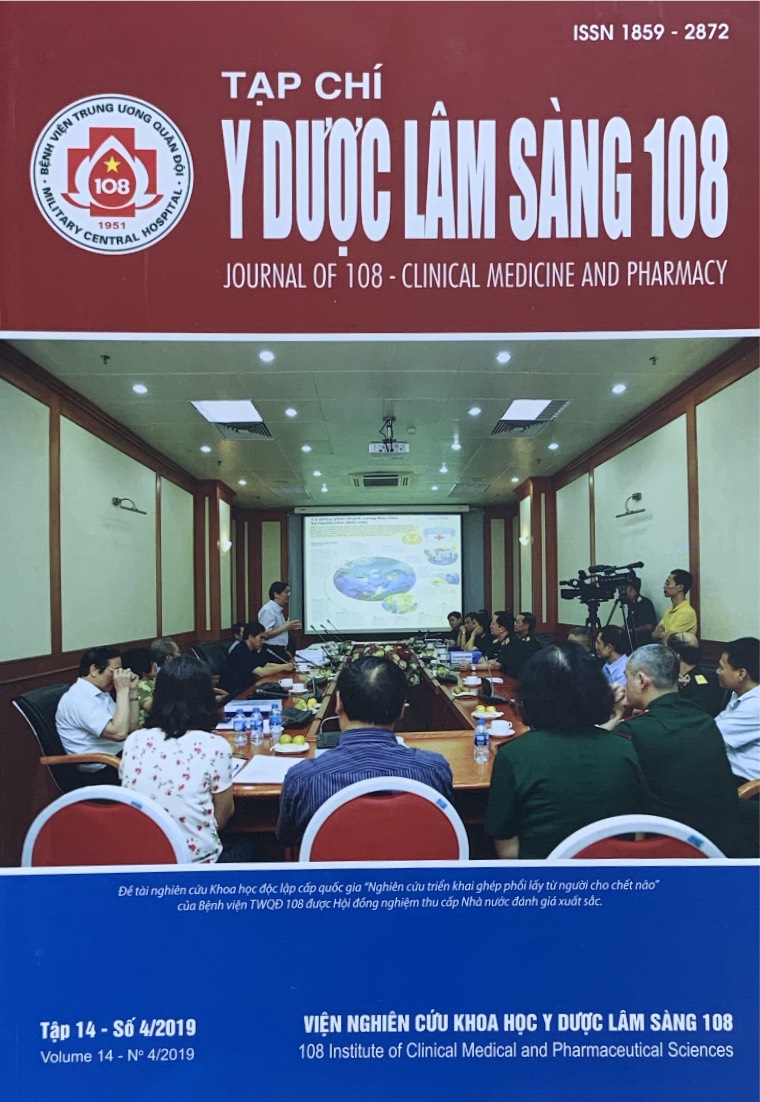Results of portal vein thrombus biopsy in patients with advanced hepatocellular carcinoma
Main Article Content
Keywords
Abstract
Objective: To assess preliminary results and safety of ultrasound-guided percutaneous biopsy of portal vein (PV) thrombi. Subject and method: A prospective descriptive study with 101 hepatocellular carcinoma (HCC) patients accompanied by PV thrombosis underwent thrombus biopsy percutaneously under ultrasound - guiding using Fastgun. Result: The techniques were successful in all patiens (adequate specimens were obtained in all 101 patients), no complications occurred. The patients discomfort during biopsy was the same as the discomfort experienced during previous liver biopsies. All 101 specimens contained malignant hepatic cells inside the thrombi. Well, moderately and poorly differentiated adenocarcinoma were seen in 57.4%, 33.7%, and 8.9% respectively. Conclusion: It can be concluded that portal vein thrombi in HCC were the metastatic lesions from liver tumors, ultrasound-guided percutaneous biopsy of portal vein thrombus is safe, reliable procedure.
Article Details
References
2. Bộ Y tế Việt Nam (2012) Hướng dẫn chẩn đoán và điều trị ung thư tế bào gan nguyên phát. Quyết định số 5250/QĐ-BYT.
3. Floridi C et al (2017) Yttrium-90 radioembolization treatment for unresectable hepatocellular carcinoma: A single-centre prognostic factors analysis. Medical Oncology 34(10): 174.
4. Erwin Kuntz and Hans-Dieter Kuntz (2006) Hepatology, principles and practice: History, morphology, biochemistry, diagnostics, clinic, therapy. Springer Science & Business Media.
5. Gerald DD, Brian IC (1993) Percuatneous biopsy of portal vein thrombus: A New staging technique for hepatocellular carcinoma. AJR 161: 229-233.
6. Gregory CC, Rui C, Ollivier H et al (2008) Incidence, risk factors and consequences of portal vein and systemic thromboses in hepatocellular carcinoma. Thromb Res 122(3): 299-306.
7. Jie S, Eric CH Lai, Nam L et al (2011) A new classification for hepatocellular carcinoma with portal vein tumor thrombus. J Hepatobiliary Pancreat Sci 18: 74-80.
8. Katsuaki T et al (1993) Diagnosis of portal vein thrombosis in patients with hepatocellular carcinoma: Efficacy of color Doppler sonography compared with angiography. AJR 160: 1279-1283.
9. Masamichi K (2002) Pathological evolution of early Hepato-cellular carcinoma. Oncology 62(1): 43-47.
10. Tublin ME, Dodd GD, Baron RL (1997) Benign and malignant portal vein thrombosis: Differentiation by CT characteristics. AJR; 168:719-723.
11. Nishant P, Boris A, Zili H et al (2010) Hepatocellular carcinoma presenting as an incidental isolated malignant portal vein thrombosis. J Gastrointest Canc, DOI 10.1007/s12029-010-9235z (Abstract on Pubmed).
12. Pasiri S, Teerha P, Wiwatana T, Nualta A, Surat T (2000) Review of 336 patients with hepatocellular carcinoma at Songklanagarynd Hospital. World J Gastroentero 6(3): 339-343.
13. Tenzin N, Prashant P et al (2011) Portal vein thrombosis-clinical profile. JIACM 12(2): 134-140.
 ISSN: 1859 - 2872
ISSN: 1859 - 2872
